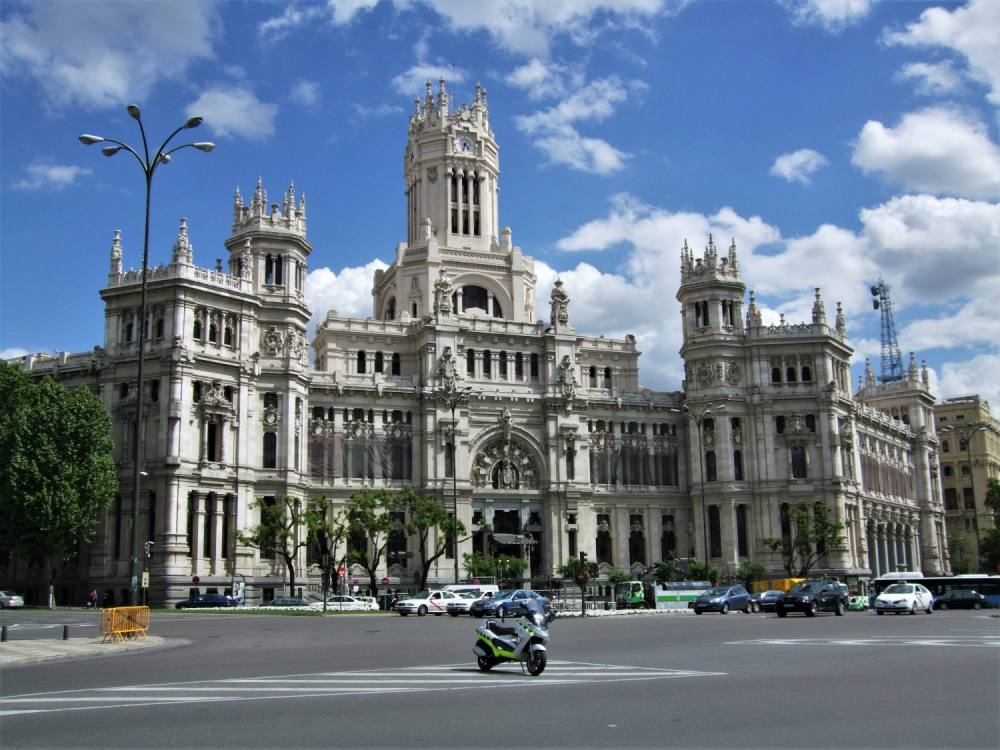- Madrid was our first stop in Spain. As a capital city it doesn’t have the pull of Paris, Rome, or Athens, but we found it a worthwhile destination.
- The city had little historical significance before 1561 when King Felipe II moved his court from Toledo. To establish Madrid’s position as the ‘modern’ capital major building programs were undertaken. Examples include the Plaza Mayor, and the Royal Palace and surrounding gardens.
- If for no other reason, go to Madrid to visit its phenomenal art galleries. We spent many hours savouring the delights of the Reina Sofia, and the Prado. (We didn’t get to the Thyssen-Bornemisza.)
- From a trip planning perspective, Madrid is also an excellent hub for getting to and travelling within Spain. It was straightforward to come by train from southern France to Madrid. We took an amazing day trip from Madrid to Segovia, about 90 kms to the northwest. And we could easily transit south from Madrid to Toledo, then on to Andalucia.
- Plaza Mayor is Madrid’s vibrant main square, notable for the frescoed Casa de la Panaderia. We visited during the Fiesta de San Isidro (the city’s patron saint) and various events were being held in the square. We enjoyed wandering the surrounding streets, getting a feel for Spain’s capital city.
- Just to the west of Plaza Mayor is Catedral de Nuestra Senora de la Almudena. It dates from 1883 but wasn’t finished until 1993, and has an interesting modern ceiling. Being Sunday morning it was fun to watch families and friends catching up outside the cathedral.
- Plaza de Oriente stands at the front of Palacio Real and has an imposing statue of Felipe IV who was king of Spain in the early 17th C.
- Built on the site of a 9th C Moorish castle overlooking the Manzanares river, Palacio Real (the royal palace) was commissioned by King Felipe V in 1735 to outshine his European rivals. It’s absolutely massive, with ~3,500 rooms. There are great views from Plaza de la Armeria and the royal armoury (armeria) is worth a visit.
- Just south of the palace complex is Basilica de San Francisco el Grande, a charming baroque building which houses a beautiful painting by Goya.
- From there we wandered down to Rio Manzanares. The heavily buttressed Puente de Segovia looked over-engineered for the trickling river.
- The palace complex is surrounded by gardens. We visited Campo del Moro, a large garden situated between Palacio Real and the river. We also visited the French-style Jardines de Sabatini at the northen edge of the palace complex.
![Basilica de San Franicsco]()
Basilica de San Franicsco
- Madrid’s famous galleries lie to the east of the city centre. On our way from the hotel to Reina Sofia we passed Escuelas Pías de San Fernando, a university library and auditorium built in the ruins of an 18th C church, and checked out the shop fronts and streetscapes.
- Centro de Arte Reina Sofia has a fabulous collection of Spanish modern art. Pablo Picasso’s Guernica is its centrepiece. It also has rooms dedicated to the work of Juan Gris, Joan Miro, and Salvador Dali amongst others.
- Nearby is Antigua Estacion de Atocha, the old Atocha railway station. It’s been beautifully restored as a rail terminus with a lush garden inside.
- Another day we visited the Prado, walking via Plaza de Cibeles which is flanked by the Palacio de Cibeles, formerly the city’s post office.
- Museo del Prado is justifiably ranked as one of the world’s top art museums. It has a broad collection of European art, with a particular focus on the great Spanish painters Velazquez and Goya, along with El Greco (the Greek) who lived and worked in Toledo for the last 40 years of his life.
- Nearby is the gothic Iglesia de San Jeronimo el Real, founded in 1503 by the Catholic Monarchs (Ferdinand and Isabel).
- Just south of the Prado lies Real Jardin Botanico (the royal botantical gardens). It’s a pleasant antidote to the intensity of the art museums and the bustle of the city.
![Escuelas Pías de San Fernando]()
Escuelas Pías de San Fernando
- We took a day trip from Madrid to Segovia which was just fantastic. It only takes 35 minutes to get there on the high speed train.
- The Romans occupied Segovia from 80 BC. The city was at the frontline of battles between Moors and Christians from the 8th C. It was resettled by Christians around 1085 after the capture of Toledo and its Alcázar dates to this period. Segovia boasts a number of Romanesque churches from the 12th and 13th C. From the 15th C it became a favoured location of the Spanish royalty and its gothic cathedral is a powerful expression of this patronage. There is well-preserved architecture from all these periods and the Old Town of Segovia and its Aqueduct is a World Heritage site.
- Old Segovia sits atop a ridge running east to west. It’s a 20 minute walk from the train station to the old city. The first major site you come across is the extraordinary Roman aqueduct with 128 pillars spanning 813 metres in length.
- From here we wound along Calle Juan Bravo to arrive at the lovely Plaza de San Martin. It features a statue of Juan Bravo who was a rebel leader in the Castilian Revolt of the Comuneros, a civilian uprising in 1520 against the rule of Charles I. The lovely Romanesque church of St Martin (Iglesia de San Martin) has a Moorish tower with distinctive brickwork and elegant arches.
- Following the streets that wind along the ridge you come to Plaza Major. The massive gothic Catedral stands on the western edge of the plaza. It was commenced in 1525 after an earlier romanesque cathedral next to the Alcazar was destroyed in Revolt of the Comuneros. The Catedral has some beautiful chapels (capillas) and a lovely cloister.
- Between the Catedral and Alcazar there are several interesting things to see. Iglesia de San Esteban is a 13th C romanesque church with a six-storey tower. Iglesia de San Andres is another lovely romanesque church with a Moorish tower and baroque interior. Casa de Sol is a former fortress within the city walls which now houses the Museum of Segovia. The ridge on which Segovia is built begins to narrow at this point and you can see the walls, the underlying rock, the river valleys, and surrounding countryside. In the slanting light of late afternoon it was all very beautiful.
- The Alcazar (castle) stands on a site that has been fortified since Roman times and takes its name from the Moors. It was expanded in the middle ages when Segovia was a favoured location of the Spanish royalty. After the royal court settled in Madrid in 1561 the Alczar became a state prison for 200 years then a military school for 100 years. In 1862 it was badly damaged by fire and the spectacular roofline you see today is a reconstruction from after that event. The interior has many highlights including the Throne Room and Hall of Rope where Moorish influences on post-Reconquista Spain are plain for all to see.
- Reaching the Alcazar felt like a fitting conclusion to the day, but Segovia had yet more to offer. Beyond the old city’s walls stand several churches and convents. We visited Iglesia de la Vera Cruz, built in the 13th C by the Knights Templar to house what was said to be a piece of the true cross (vera cruz). It’s a gorgeous little 12-sided building.
- We walked back through the city to the station and caught a late train to Madrid, tired but exhilharated by the charms of Segovia.
![statue of Castillian folk master]()
statue of Castillian folk master





















































